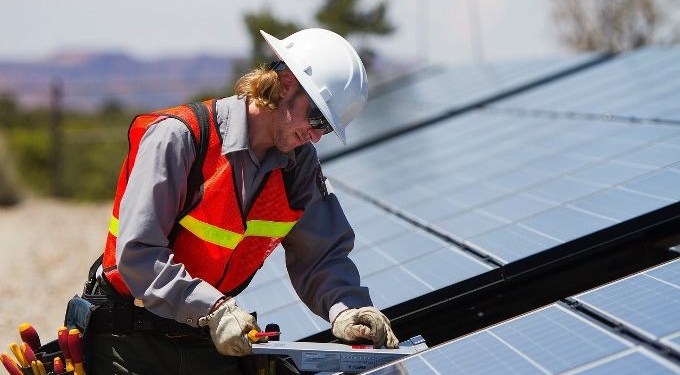
By Kenny Stancil | Common Dreams
While President Donald Trump has baselessly attacked plans to eradicate fossil fuel-based sources of energy from the United States' power grid on the grounds that doing so would be expensive and economically destructive, a new analysis reveals the opposite to be true—aggressively transitioning to 100% renewables would save Americans up to $321 billion per year while reducing harmful greenhouse gas emissions that are heating the planet.
The report (pdf), No Place Like Home: Fighting Climate Change (And Saving Money) by Electrifying America's Households, published Wednesday by Rewiring America shows that a complete switch to clean energy sources like solar and wind would not only put the U.S. on a path toward zero emissions, but it would also save each household on average between $1,050 to $2,585 per year on utility bills.
“Too often we are told doing the right thing for the environment requires sacrifice and costs more,” Adam Zurofsky, executive director of the energy policy organization, told The Guardian. “But no one is talking about the upside—we can actually make a better economy and save people money and a byproduct will be to cut emissions from residential buildings.”
"Decarbonize, save money, clean up the air…what are we waiting for?" – We couldn't agree more @drvox. There's no time to waste.
If you want to save money, create jobs in your zip code, and fight #climatechange, it's time to #electrifyeverything.https://t.co/sdHqEYblnX https://t.co/4Pw6eCnc6l
— Rewiring America (@rewiringamerica) October 22, 2020
According to the study, more than 40% of the nation's energy-related carbon emissions are determined by daily activities like bathing, cooking, and commuting. Today, most of the household appliances and neighborhood infrastructure used to facilitate refrigeration, lighting, heating, cooling, and mobility are powered by fossil fuels.
But, the researchers explain, the process of extracting and delivering dirty energy to households and communities is enormously wasteful and costly.
If we “electrify” residential buildings and “decarbonize” what the authors call “life infrastructure” by linking household consumption to renewable sources of power, we can reduce energy use, costs, and emissions, they say, and therefore “fight climate change starting right in our own homes.”
The report states that “electrification is the only viable pathway to decarbonizing a household.” The authors say that doing so “is possible with the technology we have now,” giving several examples of changes that could be adopted:
We can decarbonize our driving with electric cars, and charge them cleanly with solar on our rooftops and renewable electricity from the grid. Where most homes now burn methane in the kitchen to run the stove, we can switch to electric induction for cooking… We can use electric water heaters, or better still, heat pump hot water heaters that more efficiently provide us with hot showers and warm water. A heat pump, potentially with energy storage cheaply attached, can replace our furnace or other heating systems with electricity. We can buy electric clothes dryers to replace natural gas ones.
“To make this all work,” the report notes, “we need to install a bigger load center, wire in electric car chargers, and attach a battery capable of running the loads in the house for a half-day or so.”
One of the biggest barriers to change may be the high upfront costs associated with upgrading household infrastructure—yet, as the report points out, “we only succeed in fighting climate change if all households can transition to the new economy.”
In order to ensure an equitable and environmentally just future, the authors advocate harnessing the power of the state to implement “creative policy solutions,” from low-cost financing to direct purchasing assistance for low- and moderate-income households and those with low credit scores.
Zurofsky told The Guardian that “the federal government can make it ‘dirt cheap' for people to switch to renewables,” especially now that solar is the cheapest form of electricity in human history.
In addition to public subsidies, the report acknowledges that “regulatory reform and restructuring of monopoly control of energy services is absolutely necessary.”
Transforming household energy consumption would not only result in the decarbonization of more than 40% of the U.S. economy, but the efficiency gains would also generate savings that “are more than enough to return money to households,” Zurofsky said.
As the report notes, “It is the poorest households that have the most to gain from household energy savings.”
The authors write that “if we apply the same technologies and approaches to the commercial sector, it would eliminate around 65% of emissions.”
Bryan Snyder, an energy and environment expert at Louisiana State University, told The Guardian that such an undertaking would be difficult because it would require the country “to build an electrical generation system on top of our roofs that is the same size as contemporary U.S. generation,” while regional inconsistencies in sunlight would add to the challenge.
Zurofsky retorted that the widespread adoption of rooftop solar power is feasible. “That does not mean it will be easy to do,” he said, “or that we won't have to stretch our existing capacities to make it happen.”
According to Zurofsky, Rewiring America's new report—which echoes a recent study by the Economic Policy Institute confirming that investments in energy efficiency and clean energy would create millions of jobs—is meant to demonstrate “what the future can look like if we are motivated to make it so.”
Our work is licensed under a Creative Commons Attribution-Share Alike 3.0 License. Feel free to republish and share it widely.














![Everything You Ever Wanted to Know About 9/11 Conspiracy Theory in Under 5 Minutes [VIDEO] | by James Corbett](https://consciouslifenews.com/wp-content/uploads/2018/09/911-a-conspiracy-theory-120x86.jpg)
